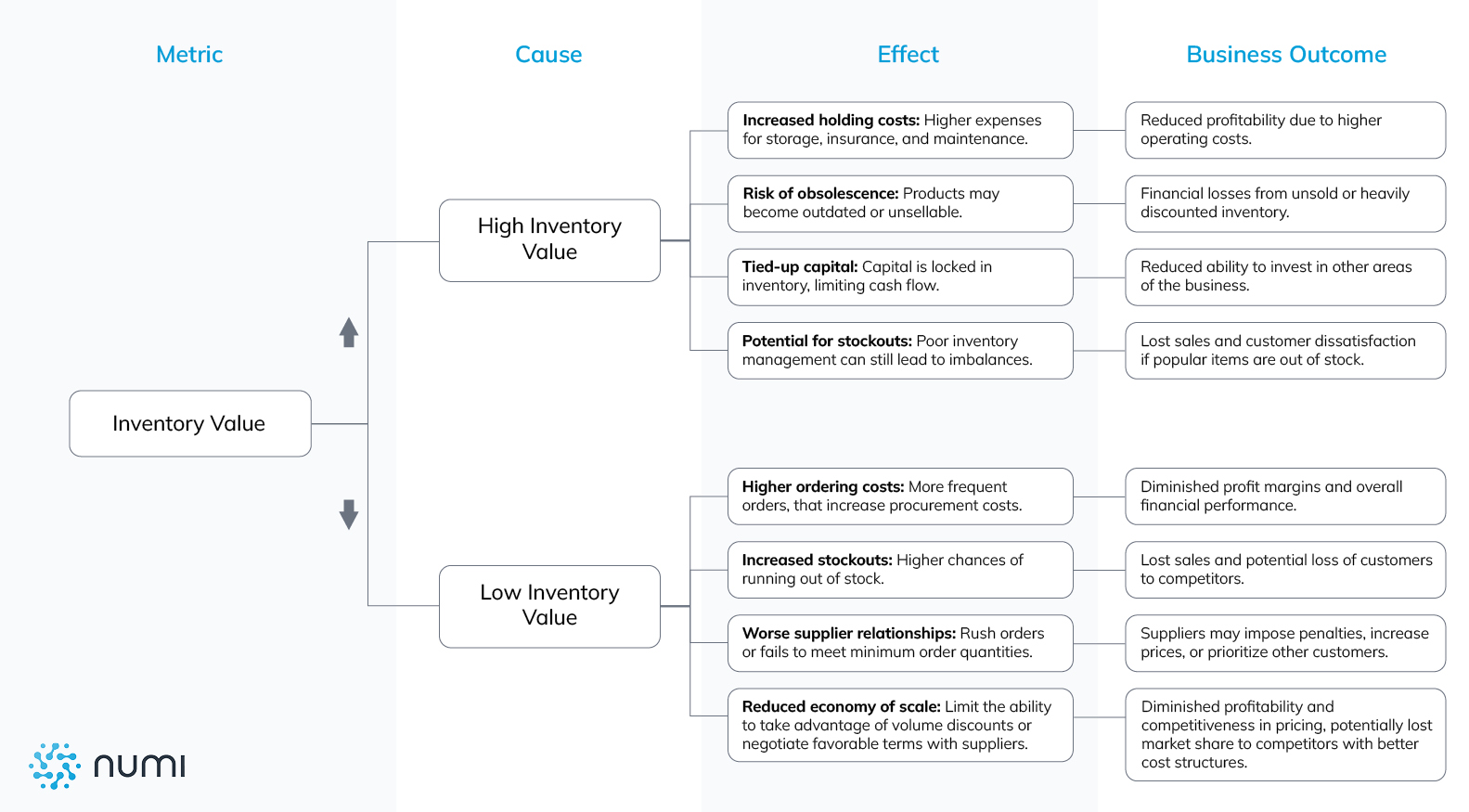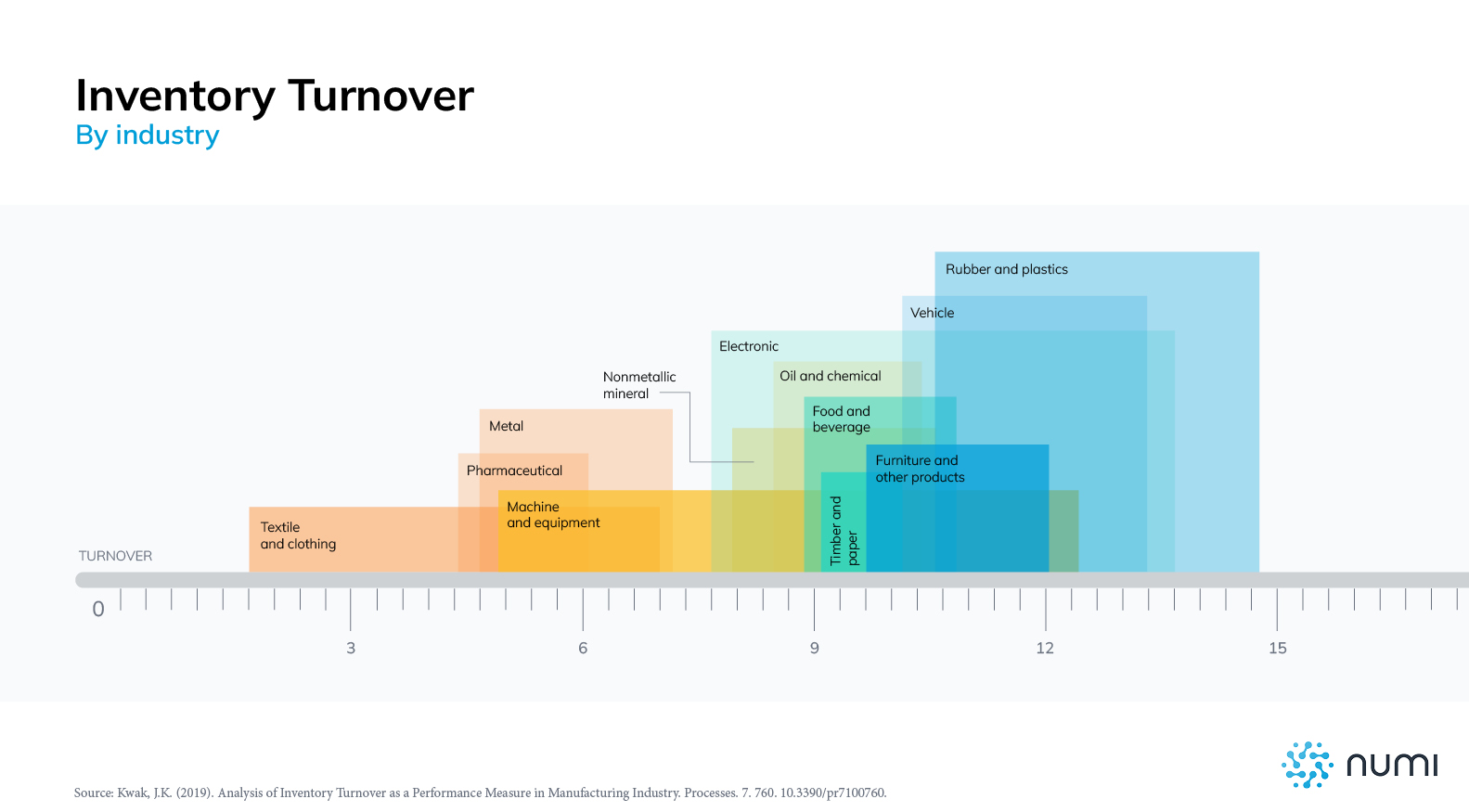
Inventory KPIs: Inventory coverage, turnover and value

Yulia Fedorova
19 Jul 2024
Inventory Key Performance Indicators (KPIs) are essential for the effective management and optimization of inventory, helping companies navigate the intricacies of stock management, supply chain efficiency, and customer satisfaction. By accurately monitoring and analyzing these KPIs, businesses can obtain crucial insights into their inventory performance, ensure that their stock levels match market demand, and pave the way for operational excellence and financial growth.
Monitoring and managing inventory KPIs can provide companies with several strategic benefits:
- Data-driven insights: Inventory KPIs provide valuable data that can help companies make informed decisions about stock levels, procurement strategies, and operational improvements.
- Resource optimization: Accurate tracking helps in optimizing inventory levels, reducing waste, and ensuring that resources are used efficiently.
- Cost reduction: Inventory KPIs enable better control over inventory-related costs, helping companies reduce holding costs and improve gross margins.
- Operational efficiency: Companies that effectively track and manage inventory KPIs can streamline their supply chain processes, leading to enhanced operational efficiency.
- Customer satisfaction: Accurate inventory management ensures that companies can meet customer demand without overstocking or experiencing stockouts, leading to higher customer satisfaction and loyalty.
By leveraging these inventory KPIs, companies can achieve greater control over their inventory management processes, resulting in improved operational performance and a stronger competitive edge in the market.
Challenges in tracking inventory KPIs
Tracking inventory KPIs is essential for effective inventory management, but it comes with its own set of challenges. Businesses must ensure data accuracy, integrate systems, select appropriate KPIs, break down data siloes, and interpret data correctly. Overcoming these challenges requires investment in technology, continuous process improvement, and training.
Ensuring the accuracy and integrity of data is fundamental when tracking inventory KPIs. Inaccurate data can stem from manual entry errors, outdated records, or discrepancies between physical inventory and system records. These inaccuracies can lead to misleading KPIs, making it difficult to make informed decisions.
Real-time data collection is essential for accurate KPI tracking, but it can be challenging to achieve. Many businesses struggle with integrating real-time data from various sources, such as point-of-sale systems, warehouses, and supply chain partners. Without real-time data, KPIs may not reflect the current state of inventory, leading to suboptimal decisions. Integrating these systems to provide a unified view of inventory KPIs can be complex and requires significant effort and investment.
Choosing the right KPIs to monitor is crucial but challenging. Businesses need to identify KPIs that align with their strategic goals and provide actionable insights. Common KPIs include inventory turnover, days inventory outstanding, and stockout rate. However, selecting too many KPIs can lead to information overload, while too few may not provide a comprehensive view.
Data siloes within an organization can hinder the effective tracking of inventory KPIs. When data is scattered across different departments or systems without proper integration, it becomes challenging to get a holistic view of inventory performance. Breaking down these siloes is essential for accurate KPI tracking.
Even with accurate and timely data, interpreting KPIs correctly is crucial. Misinterpreting KPI data can lead to incorrect conclusions and actions. For instance, a high inventory turnover rate might indicate good sales but could also suggest understocking if not analyzed in context with other KPIs.
As a business grows, its inventory management needs become more complex. Systems and processes that worked for a small operation might not scale effectively, making it difficult to maintain accurate KPI tracking. Ensuring that inventory management systems can scale with the business is a significant challenge.
Types of metrics to evaluate inventory process
Various metrics can be employed to assess different aspects of the inventory process. Here are some key types of metrics, classified into different groups based on their focus and function:
Efficiency and performance metrics
- Inventory Turnover Ratio: Measures how often inventory is sold and replaced over a period. Higher turnover indicates efficient inventory management.
- Days Sales of Inventory (DSI): Indicates the average number of days it takes to sell the inventory. Lower DSI reflects efficient inventory management.
- Sell-through Rate: The percentage of inventory sold compared to the inventory received from the manufacturer. Higher sell-through rates indicate effective inventory management.
- Gross Margin Return on Investment (GMROI): Measures the return on inventory investment. Higher GMROI indicates better profitability from inventory.
- Stockout Rate: The percentage of times an item is out of stock when customers order it. Lower stockout rates improve customer satisfaction.
Cost management metrics
- Carrying Cost of Inventory: The total cost of holding inventory, including storage, insurance, and opportunity costs. Lower carrying costs indicate cost-efficient inventory management.
- Days Inventory Outstanding (DIO): Measures the average number of days that a company holds inventory before selling it. Lower DIO indicates better management of inventory levels and reduced holding costs.
Inventory level metrics
- Average Inventory: The average amount of inventory held over a specific period. Helps in understanding and managing stock levels efficiently.
- Inventory Value: Refers to the total worth of a company's inventory, representing the monetary value of all stocked goods at a specific point in time.
- Inventory-to-Sales Ratio (Inventory Coverage): Tracks the amount of stock on hand compared to sales. Helps in maintaining optimal stock levels to avoid overstocking or stockouts.
By understanding and utilizing these metrics, businesses can optimize their inventory processes, reduce costs, and enhance overall efficiency and customer satisfaction.
Definition and importance of inventory value, turnover and coverage
Inventory Value
Definition: Inventory value refers to the total worth of a company's inventory, typically based on data obtained from ERP systems. It represents the monetary value of all stocked goods at a specific point in time.
Importance: Calculating inventory value is essential for understanding the
financial implications of a company's inventory. It helps in assessing the investment
tied up in inventory and enables better decision-making regarding stock levels, purchasing,
and resource allocation.
By maintaining an accurate inventory value, businesses can:
- Evaluate financial health and liquidity.
- Optimize purchasing decisions and inventory levels.
- Improve cash flow management.
- Ensure accurate financial reporting and compliance.
- Enhance strategic planning and forecasting.

- The number of units available for each inventory item.
- The cost per unit of each item, which may include purchase, manufacturing, freight, transportation, handling and storage costs
- Detailed breakdown of inventory types (raw materials, work-in-progress, finished goods)
- Information about where inventory is stored, which can affect valuation due to location-specific costs
- Records of all inventory transactions, including purchases, sales, returns, and adjustments.
- The chosen method for inventory valuation (e.g., FIFO, LIFO, Weighted Average Cost)
This information is typically sourced from ERP or inventory management systems, ensuring that the data is accurate, up-to-date, and comprehensive for precise inventory valuation.
Inventory Turnover
Definition: Inventory turnover is a measure of how many times a company's inventory is sold and replaced over a certain period. It is calculated by dividing the 12-month sales value by the current inventory value.
Importance: High inventory turnover indicates effective inventory management, where products are sold and replaced quickly, minimizing holding costs and reducing the risk of obsolescence. This efficiency improves cash flow by freeing up capital that isn't tied up in unsold stock, thus enhancing liquidity. Regularly tracking inventory turnover aids in accurate demand forecasting, allowing businesses to adjust inventory levels to meet customer demand effectively, thereby avoiding stockouts and excess inventory. This precision supports better production scheduling and procurement strategies.
Moreover, efficient inventory turnover helps maintain optimal stock levels, reducing the need for markdowns and enhancing profit margins by ensuring products are sold at their intended prices. Maintaining an appropriate inventory turnover rate ensures that popular products are consistently available, enhancing customer satisfaction and loyalty by meeting expectations and reducing the likelihood of stockouts. Additionally, companies with higher inventory turnover rates can respond more swiftly to market changes and trends, maintaining a competitive edge by introducing new products faster and adapting to consumer preferences effectively.

- The total sales revenue over a 12-month period
- The average value of inventory held during the same period, which can be calculated using:
- The value of inventory at the start of the period
- The value of inventory at the end of the period
- Breakdown of different types of inventory (raw materials, work-in-progress, finished goods) for more detailed analysis
- Detailed records of sales transactions to ensure accuracy
- Logs of inventory additions and deductions to maintain accurate inventory levels
Inventory Coverage
Definition: Inventory coverage, also known as inventory to sales ratio, measures the number of days for which a company's current inventory will suffice based on forecasted demand. It is calculated by dividing the inventory quantity by the forecasted sales or usage quantity.
Importance: Inventory coverage supports strategic decision-making by informing pricing, promotions, production schedules, and purchasing decisions. This ensures that businesses do not overproduce or overorder, aligning inventory levels with actual market demand. Moreover, it enables better market responsiveness by aiding in accurate demand forecasting, thus maintaining product availability and reducing the risk of stockouts and overstocks. This responsiveness can provide a competitive advantage, as companies can quickly adapt to market changes.
Data Required:
- Current stock levels for each SKU
- Inventory quantities by product group or warehouse location
- Actual sales demand over previous periods to establish trends
- Projections of future sales or usage based on historical trends and market analysis
- Sales averages for the last 3, 6, and 12 months to account for seasonal variations and trends
- Stock on Order - Inventory that has been ordered but not yet received
- Stock in Transit - Inventory that is on its way to the warehouse
- Sales Back Orders or Committed Stock - Inventory allocated to customer orders but not yet shipped
- Lead times from placing an order with a supplier to receiving the inventory in the warehouse
- Pre-determined inventory thresholds to ensure optimal stock levels
Having access to this comprehensive data, typically sourced from ERP or inventory management systems, ensures that the inventory coverage calculation is precise, aiding in effective inventory management and strategic planning.
Integrating inventory KPIs with business strategy
Aligning KPIs with business objectives
To ensure that inventory KPIs are aligned with the overall business strategy and objectives, it is essential to follow a structured approach. Here are some key steps to achieve this alignment:
- Define clear metrics: Start by clearly defining the KPIs that align with your organization's goals. These metrics should be specific, measurable, achievable, relevant, and time-bound. For example, if the company's strategic goal is to improve operational efficiency, a relevant KPI could be the inventory turnover ratio.
- Map processes: Identify the key processes that directly impact the chosen KPIs. Create process maps to visualize the steps, inputs, outputs, and stakeholders involved. This mapping will help pinpoint where data should be collected and how it contributes to the KPI.
- Set baselines and targets: Establish baseline values for the selected KPIs based on historical data. Determine realistic targets for improvement and regularly compare actual performance against these baselines and targets to track progress.
- Continuous review and adjustment: Regularly review and adjust KPIs to ensure they remain aligned with evolving business objectives. This involves setting up a review schedule for the outcomes and creating benchmarks to target.
By following these steps, businesses can create a direct link between day-to-day activities and strategic goals, ensuring that inventory KPIs effectively support overall business objectives.
Cross-functional collaboration
Achieving inventory KPI targets requires seamless collaboration between different departments such as sales, finance, and operations.
- Unified objectives: Collaboration ensures that all departments are aligned with the same strategic objectives. For instance, sales, finance, and operations can work together to reduce the lost sales ratio by improving demand forecasting and inventory management processes.
- Enhanced visibility and transparency: When KPIs are connected to processes across departments, it enhances visibility and transparency. Employees at all levels can understand how their efforts contribute to the achievement of KPIs, fostering a sense of ownership and accountability.
- Data-driven decision-making: Collaboration enables different departments to share data and insights, leading to more informed decision-making. For example, real-time data on inventory levels can help sales and finance teams adjust their strategies to prevent stockouts and optimize inventory holding costs.
- Predictive analysis: Collaborative efforts allow for predictive analysis, where historical data is used to forecast future outcomes. For example, a retail business could analyze sales data alongside inventory management processes to predict demand for certain products during specific periods, enabling better resource allocation.
To take your inventory management to the next level, consider using advanced reporting and analytics tools. Such tools as numi provide real-time insights and help you make informed decisions to optimize your inventory processes.